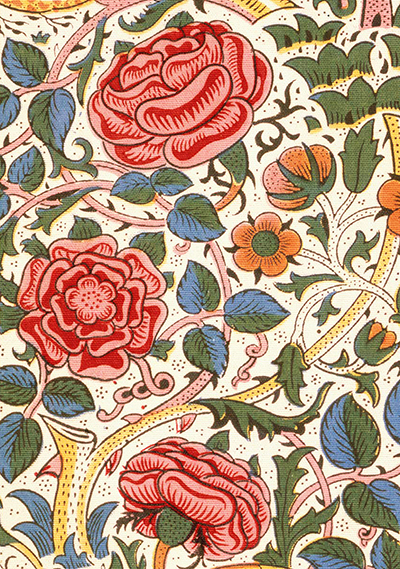Flowers were to become a fundamental part of the work of William Morris and his floral designs that were used to produce textiles, fabrics, furniture and wallpaper remain very much the signature of his entire career. We also cannot forget his contributions as a conservationist.
William Morris was remembered for being a highly skilled designer who could somehow turn the sprawling, tangled beauty of the English countryside into a form of pattern that was both clear but also beautiful. He had an inate love and devotion for this environment but was also a highly articulate artist who could carry his illustrations over into a number of different mediums. The qualities of his work have since inspired off-shoots of art movements across the world, and his reputation was certainly strong in the UK, but not restricted to this region. Many of his floral patterns have been reproduced from their date of conception all the way up to the present day and there remains a continued support for the Arts and Crafts Movement, a group in which his role was pivotal.
Many have held a love for the English countryside over the past few centuries but most successful artists have captured landscape scenes from afar, focusing on details such as a field of animals on a farm or a flowing river. Very few have managed to capture the same beauty from a far closer position. This work came very easily to Morris who felt comfortable in a natural setting, having turned his back on the city of London after living there for a short period of time. He quickly realised that this ever-expanding mass of people and industry was not to his liking, and so set up the Red House on the outskirts of the city.
The approach of Morris to capturing nature involved carefully positioned flower heads, stems and leaves that appeared to be displayed in their natural positions but were actually forming helpful patterns that could be reproduced time and time again. Each and every element of the plant or flower would be faithfully reproduced and angled in a way that would always complement the rest of the composition. After perfecting this approach the artist would then experiment with different plants in different combinations, also alternating the background colours behind his flourishes of the brush or pencil. In terms of achieving success with illustrations such as this, one instantly remembers Alphonse Mucha, although his approach tended to use them as supporting elements to a central portrait.
Morris grew up in Walthamstow, East London though during most of his lifetime it was actually a small village with a relatively rural feel. The young man travelled around nearby Epping Forest and other scenes of natural beauty within Essex and this helped to give him a love of nature from a very early age. His use of flowers and plants within his patterned designs was never just for aesthetic value - he longed to remind victorians about what we have, and what we could lose to industrialisation. In a sense, these concerns have never been satsfied and are now even more acute. The city has since expanded and swallowed up his beloved Walthamstow, just as he may have predicted. He may however be pleased to see the changing attitudes to the environment of the current generation within the UK and globally, and see it as a sign of hope for the future.
Botany was a major topic within Victorian life and as a young student William would study with great interest several publications around this. He borrowed some of his father's resources on flowers and plants and particularly appreciated the illustrations that were dotted aside the texts. This was perhaps his first introduction into the direct display of nature in art at this level of detail. These drawings may remind many of some of the work of Northern Renaissance master, Albrecht Durer, who created several related watercolours pieces such as Great Piece of Turf, Iris and Martagon Lillium many years earlier. It is possible that Morris came across this master's work too at some point in his early development.




